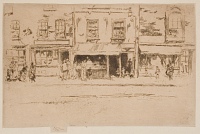Etchings Institutions search term: copley society
Fish Shop, Chelsea | ||
| Number: | 267 | |
| Date: | 1886 | |
| Medium: | etching and drypoint | |
| Size: | 141 x 218 mm | |
| Signed: | butterfly at upper left | |
| Inscribed: | no | |
| Set/Publication: | no | |
| No. of States: | 2 | |
| Known impressions: | 22 | |
| Catalogues: | K.264; M.259; W.214 | |
| Impressions taken from this plate (22) | ||
KEYWORD
TITLE
'The Fish-Shop, Chelsea' (1886, Frederick Wedmore (1844-1921)). 2
'Fish Shop Chelsea' (1887/1888, Whistler). 3
'Chelsea Fish Shop' (1889, Whistler). 4
'Maunder’s Fish Shop' (1898, Wunderlich's). 5
'The Fish-Shop: Busy Chelsea' (1909, Howard Mansfield (1849-1938)). 6
'Maunder's Fish Shop, Chelsea' (1903/1935, possibly Rosalind Birnie Philip (1873-1958)). 7
'The Fish Shop' (1905, ISSPG). 8
The etching shows Maunder's Fish Shop in a row of shops in Chelsea, but Whistler does not appear to have ever used the name. His original title 'Fish Shop, Chelsea' (with added punctuation) is therefore preferable.
Furthermore, although Mansfield's title 'The Fish-Shop: Busy Chelsea' has become popular there is no record of it being used by Whistler. The fish shop is central to the scene, but the title 'Fish Shop, Chelsea' ensures that it is not confused with Little Maunder's [273], which only shows Maunder's and not the street.
2: Wedmore 1886 A (cat. no. 214).
3: [August 1887/1888], GUW #13233.
4: List, 18 July 1889, GUW #13235.
5: New York 1898 (cat. no. 186).
6: Mansfield 1909 (cat. no. 259).
7: On verso of copper plate and on envelope containing plate, Hunterian Art Gallery.
8: London Mem. 1905 (cat. no. 214).
DESCRIPTION
SITE
The same row of houses appears in Whistler's oil painting Street in Old Chelsea [y249], painted in the early 1880s, where the fish-shop, with its light plastered walls and steep pitched roof, is just to left of centre. Maunder's also appears - in isolation - in Little Maunder's [273], and finally in the lithograph, Maunder's Fish Shop, Chelsea [c037], which is dated 1890, and where the name of the proprietor, 'MAUNDER' is seen over the open shop window, and the ominous sign 'TO BE SOLD' on the wall above.
9: Wedmore wrongly called it Milman Row, Wedmore 1886 A (cat. no. 214).
10: [June/October 1886], GUW #01755.
'The woman in the shadow of the shop,
The children gaily champing to chump-chop' 11
11: Ibid., GUW #01755.
12: Hausberg 1991 (cat. no. 25).
DISCUSSION
13: Robins 2007 , pp. 129-129.
